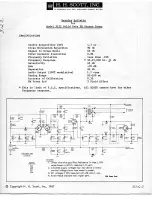
DIGITAL ECU TUNER 3 – User Manual
3) View select. (from the left: 3D Table View, Bard Display, Histograms)
4) Real time log. A set of values from the device’s inputs and outputs.
5)
A column defining the range of the engine’s speed value for a given cell.
6) A row defining a range of the load for a given cell.
7)
“Selection” area. Thanks to the selection, it is possible to modify a group of cells simultaneously.
8) Marker of a cell currently visited by the device.
9) Fist correction table. In case of Fuel and PWM table, the correction describes a proportional change of the
output signal, in case of the ignition table, the correction represents the ignition change angle.
10) Second correction table. In case of Fuel and PWM table, the correction describes a proportional change of the
output signal, in case of the ignition table, the correction represents the ignition change angle,
11)
Menu (right mouse button) enables the conduction of operations in the map’s cells:
- Enter value
(
Enter key
), displays a dialog, which enables the filling of the marked cells with the chosen value,
- Increment
(
+ key
), enables the change of the increment cell’s value by 1, with the SHIFT key pressed by 5,
- Decrement
(- key
), enables the change of the decrement cell’s value by 1, with the SHIFT key pressed by 5,
- Zero
(0 key), resets cell’s value to 0,
- Interpolate
, linearly interpolates cells’ values within a marked area.
12)
Display As...,
in case of frequency signals it is possible to change the presentation of data from the table into
real frequency values (especially important for nonlinear scales). For the analog signals, it is possible to set the
table presentation in volts.
13) Hardware version (HW ver.) and its firmware (FW ver. ). More information on the topic can be found in the
chapter
Firmware Upgrade
.
14) S
tatus bar describes the current state of the device:
-
Cannot connect
- the device is not communicating with the PC computer,
-
Connected
- the device is communicating with the PC computer,
-
Ignition sync. status NO SYNC
. – no signal (or signal incorrect) at the input Ignition #1 In,
-
Ignition sync. status SYNCHRONIZING
– synchronization of the ignition signal (for the systems with
a missing tooth). It means that the device is trying to detect the “missing tooth” gap,
-
Ignition sync. status SYNCHRONIZED
– The device is already synchronized with the ignition signal,
Page 11
www.ecumaster.com












































